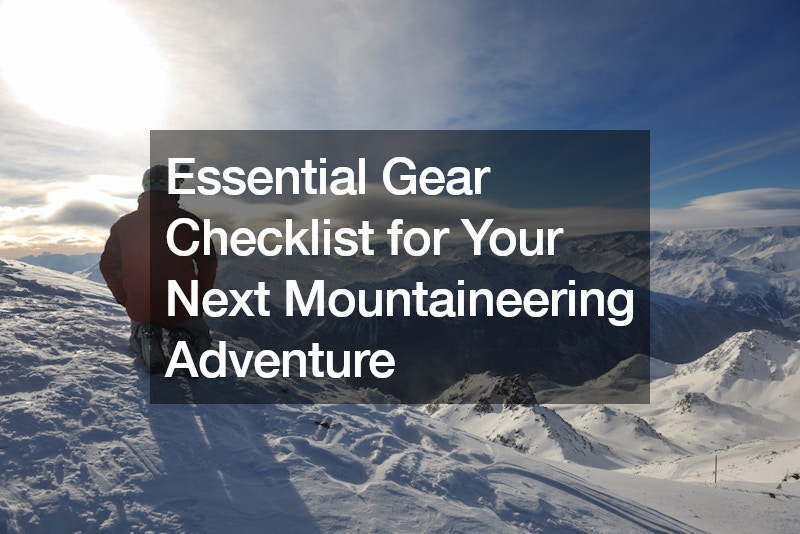Mountaineering offers an exhilarating and challenging experience, taking you to stunning heights and breathtaking vistas. However, to ensure a successful and safe climb, having the right gear is crucial. Whether you’re planning to conquer glaciated peaks in the Pacific Northwest or embark on an adventure elsewhere, here’s a comprehensive gear checklist to ensure you’re well-equipped for your next mountaineering expedition.
Head and Face
When embarking on high-altitude climbs, safeguarding your head and face from the elements is essential for your comfort and safety. Start by ensuring you have a warm hat made from synthetic or wool material in your gear arsenal.
These hats provide crucial insulation, retaining heat even when wet, and are essential for maintaining body warmth in chilly conditions.
Additionally, include a buff or balaclava in your pack for added protection against biting winds and cold temperatures. These versatile accessories can be worn in various configurations to cover your face and neck, shielding you from the harsh mountain environment.
And don’t overlook the importance of eye and skin protection at high altitudes. Equip yourself with a reliable sun hat to shield your face from intense UV rays, opting for a design that fits comfortably under your helmet. Glacier glasses with excellent side protection are essential to guard your eyes against snow glare and harmful radiation. Additionally, always carry sunscreen with at least SPF 30 and lip balm in your pack. These skincare essentials help prevent sunburn and chapped lips, ensuring your comfort and well-being throughout your mountaineering expedition.
Upper Body
Layering is key to regulating body temperature during mountaineering. Start with lightweight, long-sleeved base layers made from synthetic or wool fabric for insulation. Pack a mid-weight fleece with a hood for added warmth, and opt for a soft shell jacket as your first layer of defense against wind and light precipitation.
For heavy rain or snow, a reliable hard shell jacket with a spacious hood is essential. And don’t forget a down jacket for extreme cold, especially during breaks or summit pushes. Consider high-quality goose down jackets for combating extreme cold. During breaks or summit pushes, a down jacket offers exceptional warmth and insulation, keeping you comfortable in frigid temperatures.
Hands
Ensuring proper protection for your hands is crucial for maintaining dexterity and comfort during your mountaineering adventure. Start by packing a pair of soft shell gloves, which offer lightweight insulation and protection against moderate conditions. These gloves are ideal for everyday use while hiking or during milder weather conditions.
Additionally, include a heavy-duty pair of Gore-Tex gloves in your gear repertoire for tackling harsh weather and summit attempts. Opt for gloves with durable leather palms, as they provide enhanced grip and resilience, ensuring they can withstand the challenges of the climb.
Lower Body
Maintaining warmth and dryness in your lower body is essential for comfort and mobility during mountaineering expeditions. To achieve this, prioritize proper layering and waterproof gear. Begin by wearing lightweight base layers made from moisture-wicking materials to keep sweat at bay and provide a foundation of insulation.
Next, opt for synthetic climbing pants that offer both mobility and warmth while navigating challenging terrain. These pants should provide enough flexibility for unrestricted movement while providing insulation against the cold. For added protection against wind and precipitation, invest in a pair of hard shell pants equipped with full-length side zips. These pants act as a barrier against the elements while allowing for easy ventilation and layering over boots and crampons.
Footwear
Choosing the right footwear is important for a successful mountaineering expedition. Invest in high-quality mountaineering boots with full shanks and compatibility with crampons to provide stability and traction on varied terrain. Moreover, ensure you pack multiple pairs of medium-weight wool or synthetic socks to manage moisture and maintain warmth in your feet throughout the climb. When choosing the insulation level for your socks, take into account the temperature and terrain conditions you’ll encounter on your ascent.
Backpack
Choose a mountaineering backpack with ample capacity to carry personal gear and group equipment. Look for features like crampon pouches, ice axe attachment points, and a durable, weather-resistant construction. Use a trash compactor bag to line the interior of your pack and protect your belongings from moisture.
Climbing Equipment
Prioritize safety by equipping yourself with essential climbing gear tailored to the demands of your ascent. Start with a sturdy helmet to protect your head from potential hazards like falling debris or accidental impacts.
Furthermore, invest in a reliable alpine climbing harness designed for durability and comfort during prolonged use. Select an appropriately sized ice axe to aid in stability and self-arrest maneuvers on steep terrain. In addition to these fundamental pieces, pack both locking and non-locking carabiners for securing ropes and anchors, along with prusik cord for added safety measures while navigating vertical sections of the climb.
Hydration
Stay hydrated throughout your climb with wide-mouth water bottles for easy access to fluids. While bladder-style hydration systems are convenient for approach hikes, rely on durable water bottles for summit pushes to prevent freezing and leakage.
Medical Kit
Pack a personal medical kit with essentials like pain relievers, blister treatments, and hand sanitizer. While guides typically carry comprehensive medical supplies, having your own kit ensures you’re prepared for minor injuries or emergencies.
By following this comprehensive gear checklist, you’ll be well-prepared for your next mountaineering adventure. Remember to tailor your gear selection to the specific demands of your climb and always prioritize safety and comfort. With the right equipment and mindset, you’ll be ready to tackle any summit and create unforgettable mountaineering memories.
.




